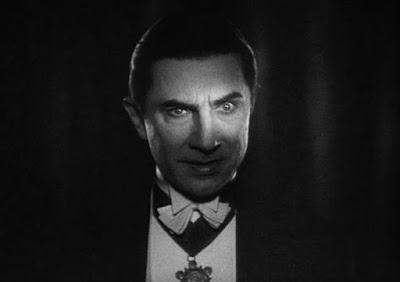For this year's Countdown to Halloween, it's all-Universal Monsters, all-the-time, from Dracula (1931) to The Creature Walks Among Us (1956). Join me daily for a fresh perspective on movies you may not have watched in a long time, if ever. Today, the one that started it all... Dracula!
With so many screen versions of Dracula produced during the last 84 years, it’s sometimes easy to overlook Universal’s 1931 original. Everyone has a favorite Dracula, whether it is Christopher Lee, Frank Langella, Jack Palance, or one of a host of others. However, every so often we should pay tribute to the original, Bela Lugosi. I daresay without his performance in the title role, few others would have followed.
We see Lugosi first rise from his coffin five minutes into
the movie. Age has been kind to the
atmosphere of Dracula. Any loss of film
quality only adds to the foggy, dreamlike quality of the scene. As his bony fingers slowly emerge from the
coffin, various rats and insects likewise crawl in and out of other confined areas
of the castle’s vast basement chamber. While we witness one of his three “brides”
actually sit up in her coffin, we only see Dracula standing by his while the
camera moves closer to his mesmerizing eyes.
His reputation precedes him.
En route to the castle, Renfield (Dwight Frye) hears from the Transylvanian
townspeople rumors that Dracula and his wives take the form of wolves and bats
and leave their coffins at night. The
stories don’t deter him, though; he’s there to deliver a lease on Carfax
Abbey. After a mysterious, driverless
carriage ride to the castle, Renfield enters a cavernous foyer where his host
slowly descends from the stairs and bids him welcome.
Renfield’s time at Castle Dracula is not long, though, and
ends with a visit from a bat and the three zombie-like brides. We next see him “aboard the Vesta,” a ship “bound
for England.” He’s now become a raving
madman, opening Dracula’s coffin and telling his master when the sun has gone
down. This scene, familiar in many other
versions of the story, unfolds here with little mystery, even though the ship
arrives in London and is found with everyone dead and its captain tied to the
wheel.
In London, Lugosi’s Dracula is the only lit man walking down
the street. On his way to the theater,
he stops for a “cocktail” from a woman selling flowers. Once arrived, he introduces himself to Doctor
Seward (Herbert Bunston), the man caring for the now institutionalized
Renfield, his daughter, Mina (Helen Chandler), her friend, Lucy (Frances Dade) and
Mina’s beau, John Harker (David Manners).
I’m not sure why Dracula is drawn to them, unless the connection is
Renfield.
Lucy finds Dracula “fascinating,” but Mina wants someone
more normal. If by “normal” she means
bland, that certainly what she has with Harker.
He’s largely ineffective as a hero.
Then again, that role is usually reserved, as it is here, for Professor
Van Helsing (Edward Van Sloan). After
Dracula quickly disposes of Lucy during a nighttime visit, Van Helsing examines
“another dead” body with the same two marks and concludes that “we are dealing
with the undead.”
Here, the 74-minute movie begins to drag and this version’s
origins as a stage play become apparent.
Van Helsing knows that Dracula is living at Carfax Abbey, but instead of
going to dispose of him right away, a couple of days pass talking about
him. I guess that’s so Dracula has time
to sink his fangs into Mina. It’s not
clear why he targets her and extends her transition instead of killing her
right away like he does his other victims.
If there are weaknesses in the screenplay by Hamilton Deane
& John L. Balderston, adapted from the play by Garrett Fort, director Tod
Browning does his best to lessen them with cobwebs and Gothic mood. And the plot holes are often filled by a
number of classic lines, including:
“I never drink… wine.”
“Listen to them.
Children of the night. What music
they make.”
“To die, to be really dead, that must be glorious!”
It all leads to Van Helsing and Harker following Dracula and
Mina to Dracula’s crypt at Carfax Abbey.
I like the creative touch of Van Helsing tearing apart a coffin lid to
make a stake, although you would have thought he’d come prepared. As you would expect from a 1931 movie, we
don’t see Dracula’s demise; instead, we only hear it as Harker searches for
Mina. She screams, he finds her and
she’s OK. “There’s nothing to fear. Dracula is dead forever.” Well, at least until the next version.
It had been a long time since I’d seen Dracula and I
recognized nuances to Lugosi’s portrayal that I had either forgotten or never
realized were there. He moves very
slowly and deliberately, appropriate for one of the undead, I suppose. While we never see him step out of his
coffin, a couple of times we see him curling up from the waist beside it. When he bends over to bite Lucy, I could
swear he smells her first. There are
times that he truly looks like he’s in pain and suffering.
And those eyes… My favorite effect in the movie is the
lighting used to highlight his eyes.
Call it glowing or pulsating, the simple strip of light across his face
accentuates that feature. If eyes really
are windows to the soul, then Lugosi’s eyes lead to a dark place that remains
scary even today. Dracula may have no
soul, but Lugosi’s performance does.
While the movie may be flawed, Lugosi is flawless. You cannot overstate what he did for Dracula,
for Universal Pictures, and for the horror genre altogether.
Tomorrow: Dracula (Spanish Version)!




No comments:
Post a Comment